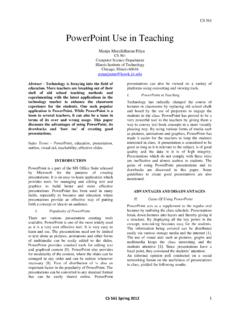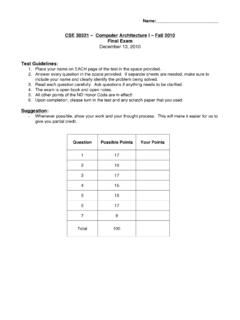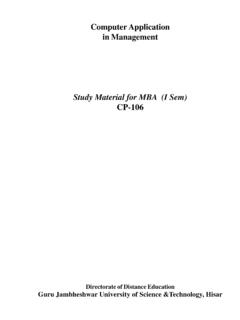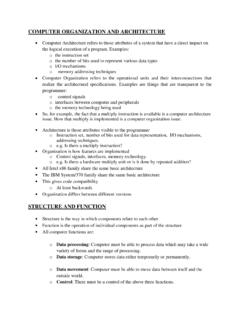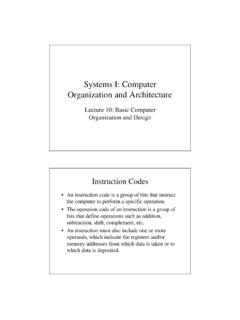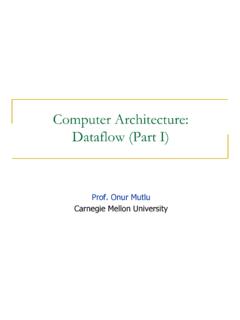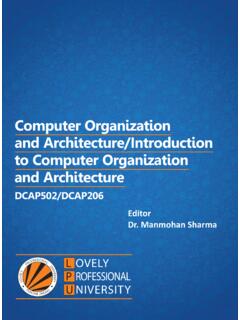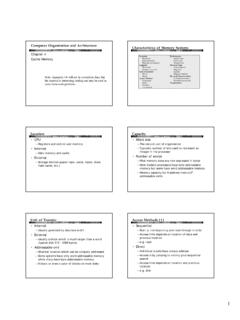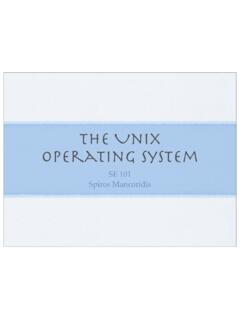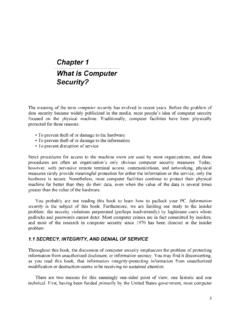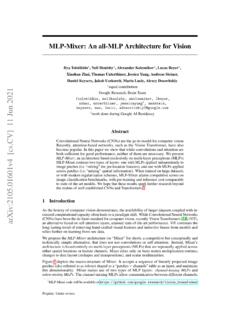Transcription of 2. Basic Organization of a Computer
1 Virgil Bistriceanu Illinois Institute of Technology192. Basic Organization of a The block diagramMost of the computers available today on the market are the so calledvonNeumann computers, simply because their main building parts, CPU orprocessor, memory, and I/O are interconnected the way von Neumannsuggested. Figure presents the Basic building blocks of today scomputers; even though there are many variations, and the level at whichthese blocks can be found is different, sometimes at the system level, othertimes at board level or even at chip level, their meaning is yet the same. CPU is the core of the Computer : allcomputation is done here andthe whole system iscontrolled by the CPU the program and the data for the program are stored in thememory I/O provide means of entering the program and data into thesystem.
2 It also allows the user to get the results of Basic Organization of a Computation and control in CPUThe computation part of the CPU, called the datapath, consists of thefollowing units: ALU (Arithmetic and Logic Unit) which performs arithmetic andlogic operations; registers to hold variables or intermediary results of computation,as well as special purpose registers; theinterconnections between them (internal buses).The datapath contains most of the CPU'sstate; this is the information theprogrammer has to save when the program is suspended; restoring thisinformation makes the computation look like nothing had state includes the user visible general purpose registers, as well as theProgram Counter (PC: it contains the address of the next instruction to beexecuted), theInterrupt Address Register (IAR: contains the address ofthe instruction being suspended), and aProgram Status Register (PSR:this usually holds the status flags for the machine, like condition codes,masks for interrupts, etc.)
3 With a few exceptions (like PC or IAR) there is no rule to indicate if somespecial signification register must be kept in the general purpose area (alsocalled theregister-file), or in a specially dedicated register. Should thestack-pointer or the frame-pointer, for instance, have special registers withdedicated hardware to help them perform the functions they are meant to,or they can simply reside in the register-file?On one hand a structure without special features is cleaner , in the sensethat it is easier to design and debug; on the other hand there are strongreasons to have special purpose registers, and the most important isefficiency. The PC, for example, is a special register, because it has aspecial function which could be otherwise impossible to perform: itscontent has to be incremented in each instruction with some value; specialhardware helps optimizing this function.
4 As a matter of fact, in manydesigns, the program counter is closer to a counter than to a simple hardware also means that some functions in the machine mayexecute in a parallel fashion, thus increasing the efficiency: using the sameexample, the program counter can be incremented while some register(s) inthe register-file are read/written, and maybe a memory access is Computation and control in CPU21It is also to be mentioned that some special registers can be accessed onlyby specialized instructions (in the case of PC only by jumps, call/return,branches, with all their variants), thus providing superior protection againstaccidental alteration, as compared with a general purpose can be long argued about what functions the ALU should perform, andthere are at least two aspects to be considered: encoding: the operation to be performed in the CPU is somewhereencoded in the instruction, using a number of bits; with n bits onecan specify 2n different binary configurations, that many ALUoperations.
5 If n is too small then it will be impossible toaccommodate the minimum number of functions the ALU shouldperform; if the designer is too greedy then fewer bits will remainavailable to encode other information in the instruction (as forinstance, where are the operands to be used, etc.), not to mentionthe explosive increase in the ALU's complexity. For the timebeing, three or four bits seem to be enough as control lines for theALU. functionality: which is the best set of operations to implement,while keeping the design at reasonable dimensions, and, in themean time without impairing the programmer's ability toimplement any function from the Basic set of functions The building blocks of a Basic Organization of a Computer22 Example OF OPERATIONS:Assume that the instruction set has instructions with the following formats:operation destination, operand1, operand2oroperation destination, operandwhere operation specifies what is to be performed with the operandsoperand1 and operand2, or with operand, and destination is the placewhere the result is to be stored.
6 Suppose also that the only logicinstructions are AND, OR, NOT. Show how to implement the XORoperation; the operands are in registers r1 and : Use the relation:A xor B =The following sequence of code implements the XOR:xor: NOT r3, r1 # the complement of A in r3 AND r3, r2, r3 # the first andNOT r2, r2 # the complement of B in r2 AND r2, r1, r2 # the second andOR r3, r2, r3 # final result in r3 Now let's consider another example in which the logic operations availableare different from those in example OF OPERATIONS:Suppose you have the same instruction formats as in example , but theonly available logic instructions are AND, OR, XOR. Implement the NOToperation; the operand is in register r1 and the content of register r0 isalways : Use the fact that:The following sequence of code implements the NOT operation:not: SUB r2, r0, 1 # make all 1's in r2 XOR r2, r2, r1 # final result in r2 The above sequence of code assumes that subtracting one from zero(integer substraction) yields a all ones result; this is true for unsigned andtwo's complement representation and B()or A and B()A xor 1A= Computation and control in CPU23 Example points out that the common case has to be consider whenchoosing an instruction set; the efforts in design will probably go towardsoptimizing the common case.
7 Certainly the designer could considerimplementing both the NOT and XOR operations in the instruction set ( have corresponding instructions): same questions emerge again, arethere enough opcodes to implement a new operation, and what is thehardware price we have to pay for it? Usually more hardware means alower clock cycle and the specter of offsetting the overall is now the time to discuss about interconnections inside the CPU and tosketch a CPU. Basically the question ishow many internal buses shouldthe CPU have?If space/low-price are a must then a single internal bus may be consideredas the one in figure This approach has however a big drawback: littleflexibility in choosing the instruction set; most operations have as anoperand the content of the accumulator, and this is also the place where theresult goes. Due to its simplicity (simple also means cheap!), this was thesolution adopted by the first we say simple we mean both hardware simplicity and softwaresimplicity: because one operand is always in the accumulator, and theaccumulator is also the destination, the instruction encoding is very simple:the instruction must only specify what is the operation to be performed andwhich is its second operand.
8 Could the designers have encoded more thanthis in the first 8-bit integrated CPUs (the Intel 8080 or the Zilog Z80, themost popular 8-bit microprocessors, both appeared in the 70s)?2 Basic Organization of a Computer24 Register FileStatus RegisterALUA ccumulatorControlIRInternal data busFIGURE A possible Organization of a CPU, using a single internal data bus. IR is the Instruction Instruction cycleVirgil Bistriceanu Illinois Institute of Technology25As the technology allowed to move to wider data paths (16, 32, 64 andeven larger in the future), it has become also possible to specify morecomplex instruction formats: more explicit operands, more registers, largeroffsets, etc. It is the moment to observe that newer CPU generations arefaster due to: faster clock rate (lower Tck); while the technology featuresdecreased more transistors fit on the same surface and they mayoperate at higher speed; lower IC: it takes fewer instructions to perform an integerinstruction on 32-bit integers, if the datapath is 32-bit wide ascompared with an 8-bit datapath; lower CPI: with a more involved hardware it is possible to makelarge transfers (read/store from/to memory in a single clock cycle,instead of several ones as it was the case with narrower presents a typical modern CPU, connected to memory.)
9 The CPUuses three buses (Op1, Op2 and Dest). The two operands are placed on thetwo buses, Op1, and Op2, an operation is performed, and the result gets onthe Dest bus to be stored in any register connected to the bus. MAR is the Memory Address Register which holds the memoryaddress during an instruction fetch on a load/store operation; MDRis the Memory Data Register, used to hold the data to bewritten into the memory during a store or to temporarily hold thedata during a load; temp is a temporary register used for internal manipulation also assumes that the only way from a register to another isthrough ALU, therefore ALU must be able to, as one of its functions, passone operand from input to Instruction cycleObviously there are at least two steps in the cycle of an instruction: fetch( the instruction is brought into CPU, more precisely into IR) Basic Organization of a Computer26At a closer look several substeps can be seen:1.
10 Instruction fetch step:MAR PCIR M [MAR]The content of PC is transferred into MAR; then the instruction at addressMAR is brought into Instruction decode / register fetch step:Decoding the instruction is the step when the control decides what shouldbe done next; if the instruction has a fixed fields format, then the contentsof registers specified in the instruction can be read into A and B at the sametime with the is also in this phase that PC has to be updated; how much is to be addedto the PC in order to get the new PC ( the address of next instruction tobe executed)? Various factors are to be considered, like instruction width,byte/word addressable memory, memory ExecutionIn the case of an arithmetic logic operation whose operands are in registersthe operation is the instruction is a load/store, then the address has to be computed andonly then the operation can be the case of a branch/jump operation the target address has to becomputed and, for a conditional branch/jump, PC may be updated or notdepending on the flag (condition) being execution step could be further divided into specific substeps for eachinstruction or class of Instruction cycleVirgil Bistriceanu Illinois Institute of Technology27Op2 busOp1 busMDRtempIARPCRFABALUDest busSRCONTROLIRMARMUXDinDoutAddressFIGURE A typical CPU Organization .



